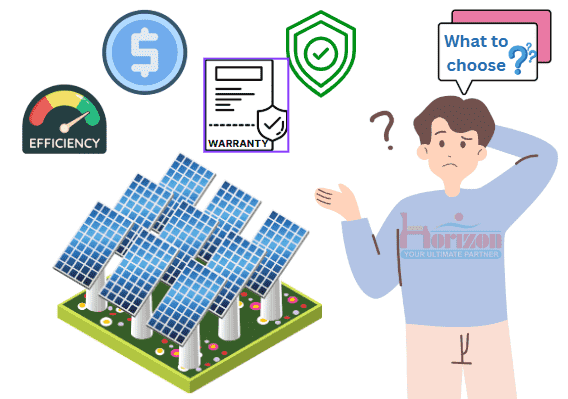
Introduction
A Grid-Tie Solar Plant allows homeowners and businesses to generate electricity while remaining connected to the power grid. While it reduces electricity bills and provides financial incentives, choosing the right system requires careful consideration of technical factors. This guide highlights essential parameters, common pitfalls, and key aspects to evaluate before purchasing a grid-tie solar system.
1. Understanding Solar Generation and Vendor Claims
a) Solar Generation and Customer Returns
Solar generation is a critical factor impacting customer returns. However, many vendors overpromise energy output, making it difficult to verify underperformance. The actual generation depends on multiple factors, including:
- Solar Radiation Levels (measured in kWh/m²/day) at your location.
- Panel Efficiency, which varies between 16% and 22% for different models.
- Shading, Soiling, and Tilt Angle, which affect real-world performance.
b) Difficulties in Pinpointing Underperformance
Due to variations in weather and location-specific conditions, identifying the root cause of low energy generation can be challenging. Factors outside the supplier’s scope, such as seasonal solar radiation variations, can impact energy production.
2. Key Components and Their Impact
a) Solar Panels
- Monocrystalline Panels: Higher efficiency (18-22%) but more expensive.
- Polycrystalline Panels: Lower efficiency (16-18%) but cost-effective.
- Bifacial Panels: Can utilize light from both sides, offering 5-20% higher yield.
- Degradation Rate: Premium panels degrade 0.3-0.5% per year, while cheaper ones degrade 0.7-1% per year, leading to lower output over 25 years.
b) Solar Inverter
- Efficiency Range: Typically 95-99% (higher is better).
- String Inverter vs. Microinverter:
- String inverters are cost-effective but lose efficiency if a single panel underperforms.
- Microinverters optimize each panel but are more expensive.
- MPPT (Maximum Power Point Tracking): Ensures panels operate at their best efficiency.
- Inverter Ratings: Inverters are rated from Tier I to Tier III. Go for the top 10 inverters with good after-sales service support.
c) Balance of System (BOS) Components
- DC Cables & Connectors: Must be UV-resistant and high-quality to minimize losses.
- Mounting Structures: Should be corrosion-resistant and withstand high wind speeds (tested for 150 km/h or higher).
- Protection Devices: Surge protection, circuit breakers, and earthing are critical for safety.
d) Installation Quality
- Poor wiring and faulty connections can lead to energy losses and fire hazards.
- Proper tilt and orientation can improve generation by 5-15%.
- Experience and Technical Qualification of the Solar Supervisor: The expertise of the supervisor plays a crucial role in ensuring a high-quality installation.
- System Reliability, Electrical Safety, and Inverter Life: A well-installed system enhances reliability, prevents electrical hazards, and extends inverter lifespan.
- Maintenance Costs and System Life: The overall longevity and cost-effectiveness of the system depend heavily on the quality of installation, which is directly influenced by the skill level of the installer.
e) Survey and Designing
- Shadow analysis and load assessment should be conducted before installation.
A well-designed system considers site-specific factors like roof strength, wind load, and local weather patterns.
3. Common Pitfalls in Buying a Grid-Tie Solar Plant
a) Overestimation of Solar Generation
- Vendors often use ideal lab conditions instead of real-world scenarios.
- Check Performance Ratio (PR): A good system should have PR of 75-85%.
b) Poor After-Sales Service
- Check vendor service track record and response time.
- Warranty periods: Panels (25 years), Inverters (5-10 years), and Installation (1-2 years).
c) Hidden Costs
- Some vendors exclude net metering, permits, or maintenance costs from the quote.
- Ensure net metering approval is included in the service package.
d) Lack of Performance Monitoring
- A good system should include online monitoring via an app or web dashboard.
- Data logging helps in tracking real-time performance and detecting faults early.
4. The True Cost of a Solar Plant: Price vs. Value
A lower initial purchase cost does not necessarily mean a cheaper total cost of ownership for a solar plant. Factors such as quality of materials, installer expertise, after-sales service, and long-term reliability play a crucial role in determining the overall cost-effectiveness of the system. Since a solar plant is a long-term investment, choosing a system based purely on the lowest price can lead to higher maintenance costs, lower efficiency, and reduced lifespan, ultimately diminishing returns.
Factors Affecting the Total Cost of Ownership:
- Panel Quality: Premium panels degrade slower, maintaining higher efficiency over time.
- Inverter Durability: A good-quality inverter lasts 10-15 years, while cheaper ones may need replacement sooner.
- Installation Standards: Poor installation can lead to frequent breakdowns and energy losses.
- After-Sales Service: Delayed maintenance and lack of support can result in extended downtime and revenue loss.
- System Efficiency: Higher efficiency systems generate more power over their lifetime, maximizing returns.
To ensure a cost-effective investment, buyers should look beyond the upfront cost and assess the overall system performance and longevity.
5. What to Look for When Buying a Grid-Tie Solar Plant
Factor |
Solar Panel Efficiency |
Inverter Efficiency |
Warranty |
Net Metering Support |
Installation Quality |
Performance Monitoring |
After-Sales Service |
What to Check |
Choose 18% or higher for better output |
Look for above 97% for optimal performance |
Panels: 25 years, Inverter: 5-10 years |
Ensure vendor helps with the application process |
Certified professionals and proper wiring methods |
Remote monitoring system included |
Quick support and maintenance availability |
Conclusion
Buying a grid-tie solar plant requires a detailed assessment of panel quality, inverter efficiency, installation standards, and after-sales service. Avoid falling for exaggerated generation claims and ensure all aspects, including net metering and monitoring, are well-integrated. Remember, the cheapest option is not always the best—invest in a reliable system that ensures maximum efficiency, lower maintenance, and long-term savings

